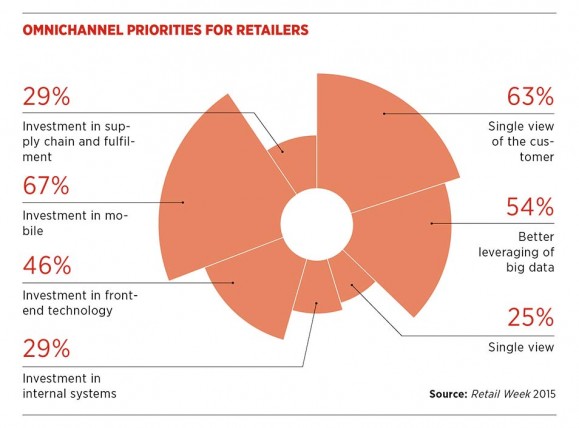“I call them our digital army,” says Bertrand Bodson, chief digital officer of Home Retail Group, when talking about the 30,000 employees at work on the front line in either Argos’s 755 stores or its distribution centres.
Despite being the head of one of the most advanced and, frankly, most interesting parts of the company, which owns the Argos and Homebase brands, he talks enthusiastically about employees who would not normally spring to mind when discussing Argos’s desire to be a leading digital retailer.
Traditional retailers must be as compelling on small screens and big screens as they are on the high street
And he’s right to do so. Amid his talk of a “fast-paced environment” and a “startup feel”, of “tech teams, product teams, user experience teams” and attracting the “top talent in London”, he knows that the best web design in the world will be for nothing if customers can’t get their products on time or ask questions of knowledgeable, helpful people.

A seamless retail experience
This attention to both sides of the customer service equation shows why Argos has made strides with its digital strategy in recent years. Given almost all of us now use multiple devices to browse for products, read reviews, compare prices and make purchases, traditional retailers must be as compelling on small screens and big screens as they are on the high street.
And, crucially, the transition customers make when they move from looking at a product in an app on their phone, say, to an internet browser in the office, to discussing its features in store must feel “seamless”, to use the jargon. If it doesn’t, it’s unlikely they’ll be back for more.
Providing a seamless experience requires a lot of co-ordination, from synchronising information such as prices, special offers and stock availability between what’s online and what’s on the ground, to organising everyone, from web designers to customer service reps, to provide a consistent brand experience.

Multiple channels
Because Argos customers had for years been moving from a catalogue at home to purchase in store, work on seamless transitions should have been more straightforward than for many firms. But, as Mr Bodson admits, Argos’s “capacity for invention” had “probably slipped a bit over the past few years”. That changed with an ambitious plan announced in late-2012 to “reinvent Argos as a digital retail leader”.
Mr Bodson came on board in July 2013. With an MBA from Harvard Business School, he cut his teeth in consulting before co-founding a website called Bragster.com to which people can upload videos of themselves doing stunts, such as eating a chocolate orange in record time. Its success saw a sale and integration with the Guinness World Records site; he then took senior roles at EMI before Argos.
Online and in store
Argos’s seamless customer experience challenge attracted him because it was at the core of the business. When he joined, 40 per cent of sales began online even though 90 per cent ended in store. “Many retailers are closer to 10-15 per cent digital and that makes it tougher” to get funding and attention, he says. Argos has staked a lot on its digital transformation and it’s clear from speaking with Bodson that he sees a seamless customer experience as a cornerstone.
Among many lessons he offers, three stand out. First, fulfil all promises made online. Many retailers “will have, let’s say, 75 per cent accuracy of their stock… but we are above 99.9 per cent accuracy, which is critical”, he says. Take a customer who finds a product on a browser at work, then reserves via their iPad, if it’s out of stock when the system shows otherwise, that customer won’t be back.
Second, firms must get the digital experience right on mobile devices. “More than £1 billion of our transactions are started on mobile now,” he says of what’s behind recent investments, and goes on – Willy Wonka style – to describe an app with “augmented reality”, another for four to eight year-olds to make online collages and so designed for “customers who cannot read yet”, and another that “works a bit like Tinder, a bit like a dating app”.
But, behind the fun, what’s crucial about mobile is it’s a great starting point for seamless transitions. Mr Bodson says: “Mobile to us is a gift because the customer gets a reservation number” added to the device and it’s the “natural link that gets you to the store and tells the person in store this is the item I have reserved, please get it for me”.
And, third, that then brings him to his 30,000-strong army in the stores and distribution centres. He describes one of the pillars of the firm’s digital transformation as “more choice, available faster” and says: “It may sound less sexy from the outside but to me it’s a big part of my job. We have completely repositioned our network of stores into a network of hub and spoke” to move stock around more easily and get customers products more quickly.
His team are also working to promise customers who have ordered and paid online to come in store, collect the product and leave again within 60 seconds if they wish. “It’s an ambition; we’re not there yet,” he concedes.
Mr Bodson and his digital army provide a good template for anyone working on a seamless customer experience. He is clear that those seamless transitions should underpin any digital strategy and it’s not enough just to bring Silicon Valley experience to a UK stalwart. It’s also vital to retrain and reorganise all the relevant bits of any traditional business to help it thrive in a digital future.

A seamless retail experience

